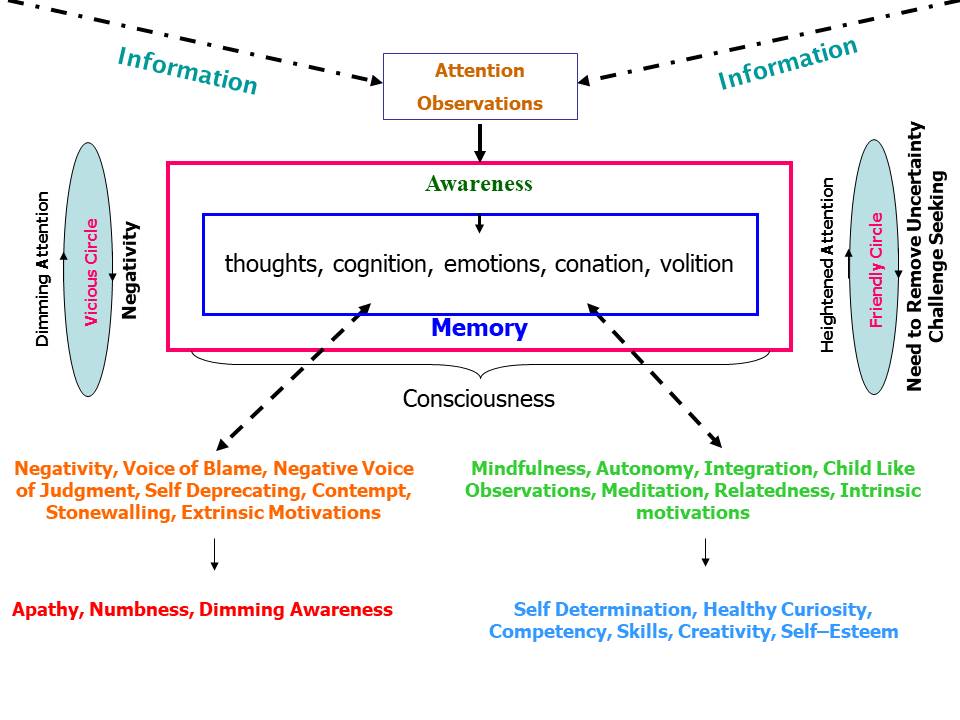First Chapter Section 7
Here we focus again on the analysis of the left side of the illustration

Dimming Attention and the Consequences of Negativity: A Scientific Perspective
Understanding the Concept of Dimming Attention
The concept of dimming attention due to negativity highlights how our perception and awareness are influenced by our mental states. When we focus on negative aspects, our awareness diminishes, creating a blind spot—a zone of diverted attention. This phenomenon can be observed across various levels of behavior, from individual psychology to broader social interactions.
The Neuroscience of Perception
Visual Perception and Cognitive Biases
The act of seeing is not merely a passive reception of visual stimuli; it is an active process influenced by cognitive biases and preferences. Research in cognitive neuroscience shows that our brain processes visual information based on prior experiences and expectations. This means we often see what we prefer to see, filtering out information that does not align with our preconceived notions. This selective attention is a survival mechanism that allows us to focus on relevant stimuli and ignore irrelevant ones.
Pain and Consciousness Modulation
The brain has mechanisms to modulate pain, often by releasing endogenous opioids that reduce pain perception. However, this comes at the cost of reduced consciousness or sensitivity. Studies have shown that pain and stress can lead to the release of chemicals like endorphins, which numb the pain but also reduce overall awareness and cognitive function.
Psychological Mechanisms of Dimming Attention
Anxiety and Boredom
When awareness is not engaged in goal-directed activity, it tends to wander, leading to unpleasant states like anxiety and boredom. These states arise because a lack of focus leaves the mind vulnerable to intrusive thoughts and worries. Research in psychology indicates that a wandering mind is often an unhappy mind, as it tends to dwell on negative possibilities more than positive ones. This phenomenon is linked to the brain’s default mode network, which becomes active when we are not focused on a specific task.
Evolutionary Perspective on Negative Bias
From an evolutionary standpoint, our brains are wired to focus more on negative events than positive ones. This negativity bias helps us prepare for potential threats and unexpected challenges, ensuring our survival. However, this focus on negative possibilities can lead to mental conflicts, resulting in emotions like depression, rage, anxiety, and envy. These negative emotions consume our cognitive resources and reduce our motivation to engage in positive activities.
Overcoming Negativity: Strategies and Benefits
Engaging in Physical and Creative Activities
One effective remedy for a wandering mind is to engage in physical activities such as running, yoga, or martial arts, as well as hobbies like carpentry, painting, or playing an instrument. These activities demand focused attention and help prevent disturbances in consciousness. They also promote the release of neurotransmitters like dopamine and serotonin, which enhance mood and cognitive function.
Lifelong Learning and Mental Stimulation
Engaging in lifelong learning, as exemplified by Justice Oliver Wendell Holmes studying Greek in his later years, keeps the mind sharp and prevents cognitive decline. Activities that challenge the brain, such as learning a new language or solving puzzles, stimulate neuroplasticity, enhancing cognitive flexibility and resilience.
Mindfulness and Meditation
Practicing mindfulness and meditation can significantly improve attention and awareness. These practices train the brain to focus on the present moment and reduce the impact of negative thoughts. Neuroscientific studies have shown that regular meditation can increase gray matter density in brain regions associated with attention, emotional regulation, and self-awareness.
Breaking the Vicious Cycle of Negativity
Recognizing and Disassembling Negative Patterns
Negative experiences and emotions create a cycle of diminished awareness and motivation. To break this cycle, it is crucial to recognize and examine negative experiences consciously. By understanding the mechanics of negative thoughts and emotions, we can disassemble them piece by piece. This cognitive restructuring helps in transforming negative patterns into positive ones.
Intrinsic Motivation and Goal Setting
Activities driven by intrinsic motivation—those performed for their inherent satisfaction—create gratifying circumstances and promote well-being. Intrinsically motivated activities align with the brain’s reward system, enhancing feelings of competence and self-determination. Setting and pursuing challenging yet achievable goals keeps individuals engaged in a positive feedback loop of growth and fulfillment.
Enhancing Cognitive and Emotional Well-being
Positive Social Interactions
Spending time with trusted and respected individuals fosters positive social interactions and emotional support. These interactions stimulate the release of oxytocin, a hormone that promotes bonding and reduces stress. Positive relationships enhance mental health and resilience, creating a supportive environment for personal growth.
Balancing Challenges and Skills
People thrive when they find tasks that match their skill levels—neither too easy nor too difficult. This balance, known as the flow state, involves being fully immersed and engaged in an activity. Flow experiences are associated with increased happiness, creativity, and productivity. By seeking and overcoming ideal challenges, individuals can maintain a continuous cycle of growth and satisfaction.
The analogy of consciousness as a productive factory emphasizes the importance of inputs (observation and attention) and machinery (awareness) in shaping our mental and emotional states. By refining these elements, we can transform negativity into positivity, enhancing our cognitive and emotional well-being. Engaging in mindfulness practices, lifelong learning, physical activities, and positive social interactions fosters a fulfilling and resilient life. Through scientific understanding and practical application, we can break the vicious cycle of negativity and create a virtuous circle of growth and happiness.
